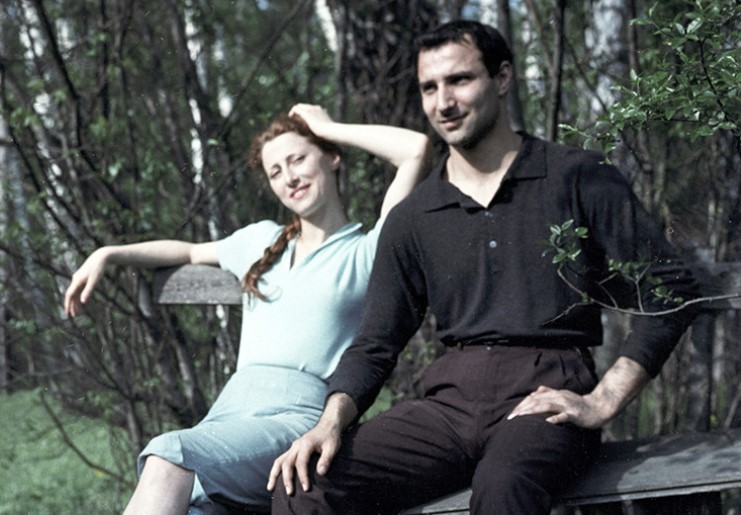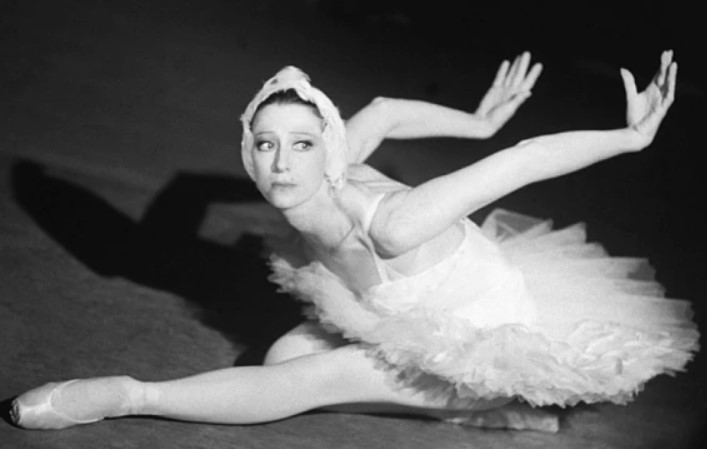Ballerina Maya Plisetskaya was the Prima Ballerina of Moscow’s Bolshoi Ballet, well recognized for her virtuous techniques and ability to incorporate high-level acting into dancing.
She was one of the most accomplished ballerinas in the 20th century with successful performances in various countries and noble awards honoring her name, especially the Full Cavalier of the Order For Merit to the Fatherland.
Table of Contents
Maya Plisetskaya Biography
- Birthname: Maya Mikhailovna Plisetskaya.
- Nationality: Russia.
- Born: November 20th, 1925.
- Died: May 2nd, 2015 (age 89).
- Parents: Mikhail Plisetski (diplomat) & Rachel Mikhailovna Messerer-Plisetskaya (silent film actress).
- Siblings: Two siblings Alexander & Azari.
- Spouse: Rodion Shchedrin.
- Children: N/A.
- Height: 5 feet 6 inches (~167 cm).
- Weight: 117 pounds (~53kg).
Early Life
Unlike many artists, Maya Plisetskaya was born into a Lithuanian Jewish family with prominent individuals.
Her father was a diplomat & engineer and her mother was an actress in silent films. Her maternal uncle and aunt were accomplished ballet dancers, and all three Plisetskaya siblings pursued this career.
Plisetskaya faced loss, fear, and war so early in her life due to the chaotic context she lived in.
The peak of terror was reached when her father was executed in the Stalinist purges and her mother was also arrested along with the newborn Azari for three years.
Taken in by her aunt Sulamith Messerer, Plisetskaya found solace in the Bolshoi Theater and ballet, like she used to do when she was younger.
After her graduation, Plisetskaya joined the Bolshoi Ballet and stayed with them for nearly half a century.
The Way To Become A Great Ballerina
From the Soviet Union …
Throughout her career, Plisetskaya has always been different. Not so long after joining the corps de ballet of the Bolshoi, she was promoted to soloist.
She was fluid, yet everything about her was powerful: the flame-like red hair, the sharp looks, how high she could jump, and how technically versatile she was.
Regardless of her potential, she didn’t receive kind treatment under the Bolshoi Ballet, partially because of her family’s political involvement and her defiance.
Instead of living on the stage as she was meant to be, she was turned into a target of degradation and excoriation for her absence from the political meetings that weren’t of interest.
During her first sixteen years with the Bolshoi, she was forbidden from going on tours abroad. Such talent became confined to provincial stages and grimy bus tours.
After getting married to Rodion Shchedrin, Plisetskaya decided that she had to defy all expectations and earn a chance to perform on grand stages all over the world.
She delivered a powerful and exceptional Swan Lake in 1956 that forced the KGB thugs to deal with the applause and cheers from the audience.
Nonetheless, such oppressive actions weren’t enough to extinguish the crowd’s excitement, hence the star Plisetskaya shone brighter than ever.
… to International Tours
Quite paranoiac but sincere with his comments, Soviet leader Nikita Khrushchev called Plisetskaya the greatest ballerina in the world and not only in the Soviet Union.
Thus, he was worried her defection might have severe consequences.
Receiving her letter with deep patriotism and acknowledging the impact she might have had on the Bolshoi Ballet’s success, Khrushchev eventually canceled the travel ban on Plisetskaya.
As expected by everyone who knew about her ability, Plisetskaya truly changed the contemporary ballet scene by pushing the standards a notch higher and introducing drama to purely technical ballet. The success made Khrushchev extremely satisfied.
It only took Plisetskaya a few years to become an international sensation, a bomb at the box office. The Soviet Union also grew to favor her so much more because she always returned instead of defecting like many dancers of her generation.
Explaining her action, Plisetskaya said she had always been taught that running to the opponent’s side would make one a traitor. Her father would never have let that happen.
Acting, Choreography, and Teaching
In the 1960s, Plisetskaya appeared in some films as an actress rather than a dancer, namely The Humpbacked Horse and Anna Karenina. The music in the latter was written by her husband and later reused.
Inspired by the event of Plisetskaya being announced as Bolshoi’s Prima Ballerina Assolute, Shchedrin made it the subject of his ballet Anna Karenina (1971).
Aside from the leading role, Plisetskaya also attempted choreography for the first time.
During her American tour in 1987, Plisetskaya taught classes at the Dance Center of David Howard. She was moving into her sixties, yet the power and suppleness in her put everyone in awe.
Contribution To Art
Plisetskaya never received top-tier coaching and training in her time, yet she drew the audience toward herself with her electrifying presence and daring style.
History Tim Scholl even described her jump as “almost masculinely powerful”. She also performed well, whether it was allegro or adagio, which was rare even among talented dancers.
Another of her signatures was the theatrical ability that seemed to seize the entire hall with one gaze or push the drama to its peak with simple gestures.
Critics believed it was a gift from her maternal side, something she exploited perfectly.
A notable example of her stage presence was Boléro by Joseph Maurice Ravel, wherein she executed a solo piece on a round stage, surrounded by forty male dancers. Numbers were never an issue, because the focus was always on Plisetskaya.
In 1959, she toured across the United States for the first time and made Spartacus “the definition of Bolshoi”. Life magazine featured this performance and ranked Plisetskaya after only Galina Ulanova.
While Ulanova evaded from roles with an edge and more demanding techniques, Plisetskaya took upon them directly and unpretentiously. The Black Swan (Swan Lake), Kitri (Don Quixote), Aurora (Sleeping Beauty), and Raymonda are the roles attached to her name.
Critics often described Plisetskaya as full of fire and power, balanced between the temperament of an artist and the optimism of youths. Rudolf Nureyev shared that Plisetskaya as Kitri made him cry from happiness.
Another milestone in Plisetskaya’s career was The Dying Swan, in which she seemed to leave her human and dancer identities behind so she could transform into a mythical creature.
This ballet was with her until her late sixties and near her retirement, and it never failed to excite the crowd.
In 1967, she attempted a more modern and abstract piece: Carmen Suit. It soon became her favorite, turned her into a living legend, and remained a Bolshoi landmark.
However, the sensuality and meaningful gestures weren’t what the Soviet Union demanded in a classical art form.
Foreign critics saw Plisetskaya as a genius with the audacity and courage to burn everything around her with vehemence and ardor. For them, the Soviet Union made a mistake when they pulled her away from modern choreography and thus limited her ability.
The Dying Swan was a piece she performed even in her sixties, yet her last performance was Ave Maya, a gift from Maurice Béjart to her for her 80-year-old celebration.
Maya Plisetskaya’s Autobiography
Maya Plisetskaya published “I, Maya Plisetskaya”, her autobiography.
In this memoir, she reminisced about the tragic childhood she went through as well as the thrilling journey to be a professional and accomplished ballerina.
The pages introduced us to the most impactful people and events in her life and shared the aspects not everyone knew about her: the struggles at the dawn of her career, the passion for keeping her up, fascinating meetings with leaders, and even the invasion of politics in her life.
Check more: Maria Alexandrova Biography
Personal Life
Family
Composer Rodion Shchedrin had a few successful collaborations with Plisetskaya before becoming her husband. Their relationship lasted until they passed away.
In the later phase of Plisetskaya’s career, the couple began to share more and more credits, specifically Anna Karenina, Carmen, The SeaGull, and more. He was acknowledged as a leading Soviet composer.
When the Soviet Union came to an end, the couple spent most of their time in Germany and sometimes visited St. Petersburg or Moscow. They founded a fund in Mainz to archive their works publicly and support aspiring artists in music and ballet.
She was one of the Russian ballerinas who chose not to have kids.
Friendships
The most special friendship Plisetskaya had was with Robert F. Kennedy, an Attorney General in the US and brother of President John F. Kennedy. They shared the same birthday and even celebrated it together.
This friendship stemmed from political benefits for the US and the Soviet Union, yet the two of them somehow found a mutual voice and developed a friendship.
She described Kennedy as romantic, noble, and pure in their connection.
Throughout her career, Plisetskaya made quite a few good friends, from her manager Maxim Gershunoff to her co-workers such as pianist Leonard Bernstein, novelist John Steinback, artist Marc Chagall, actress Ingrid Bergman, actress siblings Natalie & Lana Woods.
Maya Plisetskaya’s Death
On May 2, 2015, Plisetskaya passed away, and the cause of death was a heart attack. She was cremated as her will and after her husband followed, the ashes of their beings were combined and scattered across Russia.
The leaders of Russia and Belarus expressed their deepest condolences to her beloved family, saying she took an entire ballet era with her and the art world would never retrieve such a great loss.
Admirers all over the world have tributed Plisetskaya in various forms and means.
- 2013: A 39-foot (~13-m) mural painted by the Brazilian artist Eduardo Kobra was placed in the center of Moscow’s theater district, not far away from the Bolshoi Theatre.
- 2015: Valery Gergive, a close friend, artistic director and conductor, organized a Moscow concert in the memorial of Plisetskaya.
- 2015: The Russian government named a square near Bolshoi after her and affixed a plaque with words engraved in tribute.
- 2015: The Mariinsky Theater held a concert to pay homage to the outstanding Plisetskaya.
- 2016: The Bolshoi Theater held a concert in London to honor Plisetskaya.
Conclusion
Sometimes, we couldn’t help but wonder how far Maya Plisetskaya could have gone with her fluid movements, dramatic acting, and bold personality if she had been greeted with the artistic freedom we have today.
But after all, the limits put on her only proved that she was so powerful and prominent, overcoming all the disadvantages and turning herself into an icon for young ballerinas.



